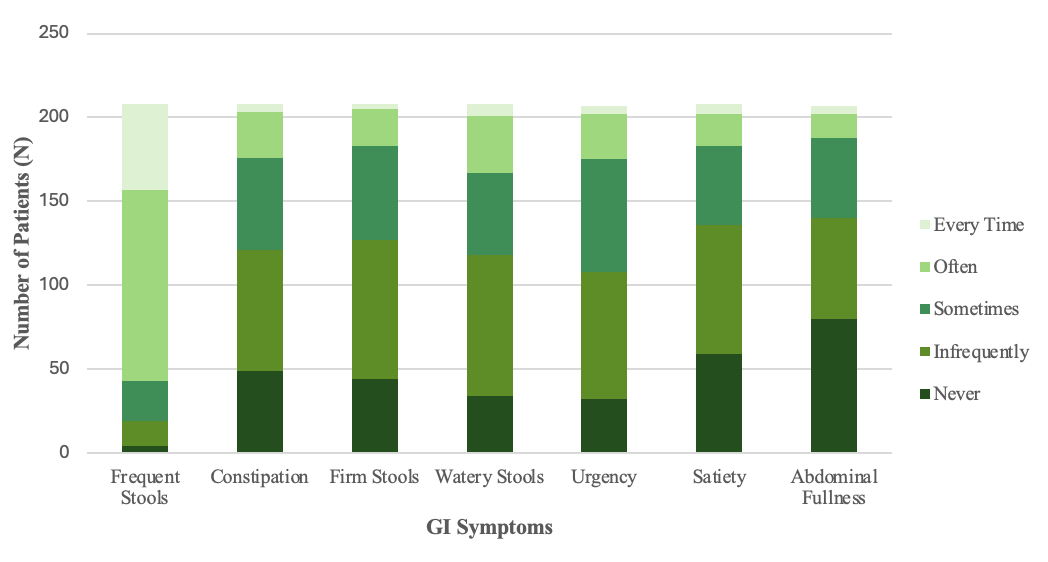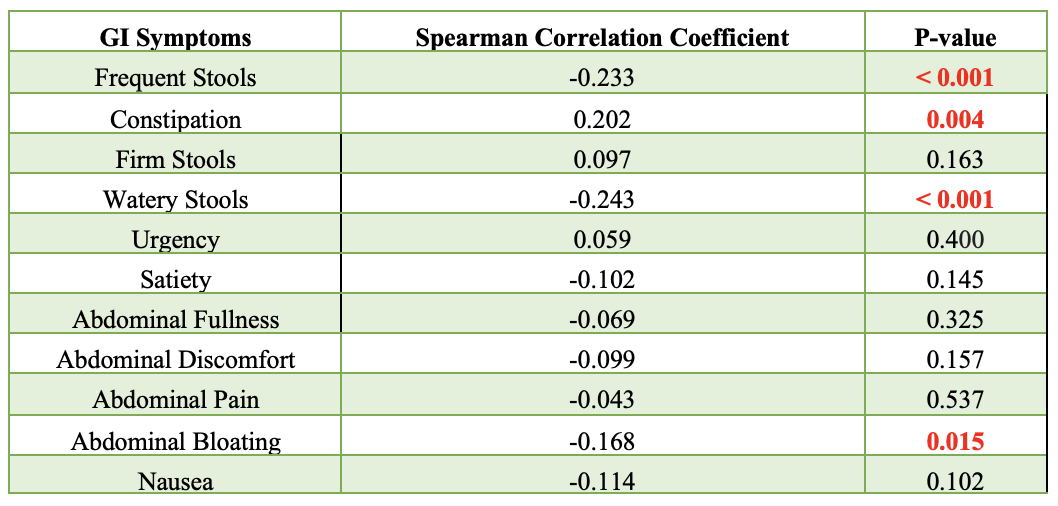Tuesday Poster Session
Category: Functional Bowel Disease
P5078 - Fecal Loading as Assessed by Computed Tomography Imaging Is Poorly Associated With Gastrointestinal Symptoms
Tuesday, October 28, 2025
10:30 AM - 4:00 PM PDT
Location: Exhibit Hall

Claire Beamish, MD
Dartmouth Hitchcock Medical Center
Lebanon, NH
Presenting Author(s)
Claire Beamish, MD, Shan Xue, MD, Michael Curley, MD, Nancy McNulty, MD, David Munger, DO, David Klibansky, MD
Dartmouth Hitchcock Medical Center, Lebanon, NH
Introduction: There is often significant discordance between patients’ personal experience with gastrointestinal (GI) symptoms and objective testing. Radiologic assessment is commonly used as a tool to aid with both diagnosis and treatment planning of GI symptoms, including a clinical assumption that symptoms correlate with stool burden seen on imaging. However, there is limited information to support the utilization of radiographic imaging in this manner. The goal of this study is to assess the association between fecal loading on imaging and GI symptoms.
Methods: A patient questionnaire was used to assess GI function and symptoms, based on elements from a previously validated symptom assessment tool. The survey was distributed to outpatients undergoing computed tomography (CT) abdomen and pelvis for any indication at a single academic center (Figure 1). Fecal burden on CT studies was evaluated by two blinded, independent subspecialty radiologists using the Starreveld scoring method. The primary outcome of the study was a determination of association between a semi-quantitative metric of fecal loading assessed by CT imaging and GI function or symptoms as determined by a survey-based tool.
Results: 208 patients were included in the study. Inter-rater reliability for CT assessment yielded a kappa score (kappa = 0.6). Spearman correlation demonstrated significant association between stool frequency, straining, liquid bowel movements, and bloating (Figure 2). GI symptoms however including urgency, early satiety, fullness, discomfort, abdominal pain, and nausea showed no association with loading scores. Binary logistic regression analysis confirmed clinically meaningful association only for metrics of stool form and frequency.
Discussion: Fecal loading, as assessed by CT, is reasonably well associated with certain measures of bowel function, including stool form and frequency. However, our results suggest it is otherwise a low-quality measure of other GI symptoms that may be attributed to fecal loading in clinical practice. This study demonstrates the limited utility of assessing fecal loading on CT imaging for the assessment of certain GI symptoms, a practice which may misguide therapy or contribute to inappropriate diagnostic anchoring.

Figure: Figure 1. Patient questionnaire results on frequency of GI symptoms

Figure: Figure 2. Spearman correlation coefficient to assess for relationship between fecal loading score and GI symptoms as reported in patient questionnaire
Disclosures:
Claire Beamish indicated no relevant financial relationships.
Shan Xue indicated no relevant financial relationships.
Michael Curley indicated no relevant financial relationships.
Nancy McNulty indicated no relevant financial relationships.
David Munger indicated no relevant financial relationships.
David Klibansky indicated no relevant financial relationships.
Claire Beamish, MD, Shan Xue, MD, Michael Curley, MD, Nancy McNulty, MD, David Munger, DO, David Klibansky, MD. P5078 - Fecal Loading as Assessed by Computed Tomography Imaging Is Poorly Associated With Gastrointestinal Symptoms, ACG 2025 Annual Scientific Meeting Abstracts. Phoenix, AZ: American College of Gastroenterology.
Dartmouth Hitchcock Medical Center, Lebanon, NH
Introduction: There is often significant discordance between patients’ personal experience with gastrointestinal (GI) symptoms and objective testing. Radiologic assessment is commonly used as a tool to aid with both diagnosis and treatment planning of GI symptoms, including a clinical assumption that symptoms correlate with stool burden seen on imaging. However, there is limited information to support the utilization of radiographic imaging in this manner. The goal of this study is to assess the association between fecal loading on imaging and GI symptoms.
Methods: A patient questionnaire was used to assess GI function and symptoms, based on elements from a previously validated symptom assessment tool. The survey was distributed to outpatients undergoing computed tomography (CT) abdomen and pelvis for any indication at a single academic center (Figure 1). Fecal burden on CT studies was evaluated by two blinded, independent subspecialty radiologists using the Starreveld scoring method. The primary outcome of the study was a determination of association between a semi-quantitative metric of fecal loading assessed by CT imaging and GI function or symptoms as determined by a survey-based tool.
Results: 208 patients were included in the study. Inter-rater reliability for CT assessment yielded a kappa score (kappa = 0.6). Spearman correlation demonstrated significant association between stool frequency, straining, liquid bowel movements, and bloating (Figure 2). GI symptoms however including urgency, early satiety, fullness, discomfort, abdominal pain, and nausea showed no association with loading scores. Binary logistic regression analysis confirmed clinically meaningful association only for metrics of stool form and frequency.
Discussion: Fecal loading, as assessed by CT, is reasonably well associated with certain measures of bowel function, including stool form and frequency. However, our results suggest it is otherwise a low-quality measure of other GI symptoms that may be attributed to fecal loading in clinical practice. This study demonstrates the limited utility of assessing fecal loading on CT imaging for the assessment of certain GI symptoms, a practice which may misguide therapy or contribute to inappropriate diagnostic anchoring.

Figure: Figure 1. Patient questionnaire results on frequency of GI symptoms

Figure: Figure 2. Spearman correlation coefficient to assess for relationship between fecal loading score and GI symptoms as reported in patient questionnaire
Disclosures:
Claire Beamish indicated no relevant financial relationships.
Shan Xue indicated no relevant financial relationships.
Michael Curley indicated no relevant financial relationships.
Nancy McNulty indicated no relevant financial relationships.
David Munger indicated no relevant financial relationships.
David Klibansky indicated no relevant financial relationships.
Claire Beamish, MD, Shan Xue, MD, Michael Curley, MD, Nancy McNulty, MD, David Munger, DO, David Klibansky, MD. P5078 - Fecal Loading as Assessed by Computed Tomography Imaging Is Poorly Associated With Gastrointestinal Symptoms, ACG 2025 Annual Scientific Meeting Abstracts. Phoenix, AZ: American College of Gastroenterology.
